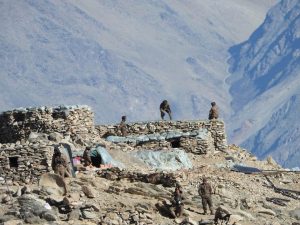How could the worsening climate crisis affect the sharpening security rivalry between nuclear powers India and China? The answer is also a warning. Climate change is likely to magnify bilateral tensions on the harsh border and shared basins of the Brahmaputra/Yarlung Tsangpo and the Indus Rivers, pushing the two rivals toward conditions ripe for conflict. But the climate security challenge can also be a pathway for cooperation, should the two nations seize the opportunity. The international community should heed this moment and play a discreet but supportive role in this process.
This is the upshot of an our recent climate security study, “Melting Mountains, Mounting Tensions.” The study (and the accompanying storymap) is a product of a collaboration between two U.S.-based research institutions, the Council on Strategic Risks and the Woodwell Climate Research Center. A distinguishing feature of this work is the cross-disciplinary nature of the team that produced it – security analysts and climate scientists, respectively, from our two organizations, who worked closely together from the outset.
Projecting climate change impacts until 2040, our study finds increased chances of floods on the Brahmaputra River in northeastern India, particularly in the months of July and September. The increase will primarily be driven by more intense spells of rainfall. Millions in the region already endure perennial floods, and our projections portend enhanced such material (i.e., physical) risk.
China’s dam-building activities could further amplify these risks. If the massive 60 GW dam project on the Great Bend of the river moves forward (as announced recently by China), it will likely be built with substantial storage capacity. This will dramatically reduce streamflow during dam-filling, a process that could take months. Additionally, the region of the Yarlung Tsangpo’s Great Bend is known to be earthquake-prone, presenting the risk of dam fracture and sudden water release in case of a major seismic event.
China is also building dams on the Indus River in Pakistani-held Kashmir, territory that India claims, and over which three of four India-Pakistan wars have been fought. These dams are a part of Beijing’s Belt and Road Initiative (BRI), which India has opposed. The study finds that glacier melt due to climate change is likely to increase streamflow above current levels in the Indus River for the next several decades, making these dam projects viable for the long term. The success of these projects could further cement the already-strong Chinese-Pakistani partnership, further entrenching the China-India rivalry.
While material risks from climate change and proposed dams are clear, equally of concern are the dangers of misperception. We argue that enhanced floods in downstream India due to climate change could lead to Indian suspicions of deliberate Chinese water manipulation, regardless of whether this is objectively true. Such risks will be the greatest during phases of particularly low bilateral trust, such as the current period.
The report also examines the impact of climate change on the physical terrain of the contested border areas, where altitudes and temperatures are harsh – particularly on the western border in Ladakh. The study projects a strong warming trend overall, with a significant reduction of extreme wind chill days in high elevation regions on the western border by 2040. This warming will provide more opportunities for troop patrols on both sides, and therefore potentially more clashes, if tensions remain high. Troops also face enhanced risk of glacial lake outburst floods and avalanches.
It is clear that climate change is no friend of de-escalation between India and China. But there’s a lot that can be done to reverse this slide. At a practical level, there is scope for greater data diplomacy – ensuring the measurement and exchange of more granular river flow data between the rivals. Early warning systems in the border region could help both sides respond to increasing natural disasters. The existing dialogue between the two militaries could benefit from including environmental security concerns. The two sides could set up joint emergency response procedures, whose actualization will prove that collaboration is possible and beneficial. Transparency is another key area for improvement. Beijing has a history of opaqueness when it comes to hydropower projects on transboundary rivers, as evidenced by the Mekong River basin experience in Southeast Asia, and this needs addressing.
As the upstream actor, China will need to make the first move, but India will also have to respond. The international community can support this process unobtrusively, with technical assistance if desired by the parties but also with encouragement for environmental confidence building. The grand prize – admittedly an aspirational goal – would be a comprehensive river basin management treaty involving all relevant riparian states for the Brahmaputra and the Indus.
“Melting Mountains, Mounting Tensions” aims to address only one piece of the overall puzzle of tracking and forecasting the multifaceted India-China rivalry. It however shows the value of a cross-disciplinary approach to preparing for the complex geopolitical risks of the future in climate-threatened Asia and elsewhere.

































